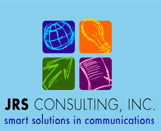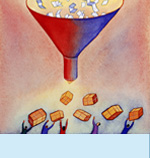How to Develop Compelling Marketing
Programs That Generate Sales
One of the most unusual projects in my early public relations agency career involved the production of an exercise video that featured a woman teaching calisthenics to be done while cleaning a toilet, appropriately called “Dip and Disinfect.” (Who could make this up?) The video prominently displayed a toilet bowl cleaner, made by our client, and was distributed to television stations nationwide with the suggestion that it be aired during National Fitness Week.
Evaluation of the success of the video was based on the number of times it aired. We had no evidence of any kind of association between bathroom cleaning and fitness in our consumers’ minds. Specifics on usage of the video escape me, but I am quite sure there was never a “Dip and Disinfect II.”
The video is an example of an idea that gets attention for a product by focusing on “making a splash” (if you’ll pardon the pun with this toilet cleaner example). However, I am hard pressed to defend this strategy when it comes to building a brand in the mind of target consumers or generating increased sales.
Instead, I have found that the most effective marketing programs are based on an understanding of the target consumer, with an overall strategy and tactics that offer emotional appeal. In other words, market research is quite often the deal-breaker that helps you create powerful, compelling marketing communications programs.
I offer the following two case studies as examples of how market research served as the foundation for effective marketing programs that developed brands and generated sales.
Getting Consumers to Crave Your Product
In 2004, mangos were the #1 most consumed fruit outside of the U.S.; however, only one in three Americans had ever bought one. EMEX, an association of Mexican mango producers and shippers, retained public relations firm Lewis & Neale to conduct a four-month campaign (limited to the mango season) to increase fresh mango visibility and consumption in the U.S.
Lewis & Neale asked JRS Consulting to identify why the world’s favorite fruit had such low U.S. consumption, test messages among Anglo and Hispanic consumers and collaborate on developing a positioning for Mexican Mangos.
Our research showed that heavy mango users felt so passionately about their favorite fruit’s distinct flavor that they actually craved it. Yet most American consumers weren’t buying mangos because they didn’t know how to select, prepare or eat them.
Furthermore, the research revealed a significant marketing communications opportunity for mangos: two-thirds of consumers in our Awareness, Trial and Usage (ATU) study reported that they would purchase mangos more frequently if they knew more about them. Yet only 15% of those surveyed indicated that they had read or heard any information about fresh mangos in the past year.
Overall, focus groups and the ATU study clearly showed that exposure to mangos wasn’t enough; the key to increased mango sales was consumer education about the purchase, preparation, usage and benefits of mangos.
Lewis & Neale then mounted a bilingual educational campaign via the media and at retail point-of-sale locations, using messages and visuals suggested by the research. Communicating mangos’ many healthful benefits as well as how to select and cut mangos and use them in cooking reinforced the more emotional appeal of the fruit and enticed people to try it. Mangos from Mexico's web site, marketing materials and knowledgeable merchandising representatives therefore emphasized both mangos' powerful imagery as well as very practical information about preparation.
As a result of the public relations program, Mangos from Mexico sales increased by 13% during the four months of the product’s availability.
Generating Beautiful Sales Through Emotional Benefits
When public relations agency Kemper Lesnik introduced Renova, a Johnson & Johnson prescription drug that reduces wrinkles, JRS Consulting, Inc. conducted focus groups to explore how women felt about the aging process. Our in-depth discussions revealed that when it comes to wrinkles, women think “beauty” and not “medicine.” The emotional benefit associated with using Renova was that women would feel more attractive if they reduced their wrinkles. However, feeling attractive was more associated with a setting that suggested pampering and self-improvement rather than the clinical image of a physician’s office.
To convey this idea, Kemper Lesnik effectively positioned Renova as a cosmetic rather than a prescribed medication. They offered dermatologists at Nordstrom’s cosmetic counters and booked dermatologists on the air to link skin care and beauty with Renova. According to Kemper Lesnik, Renova prescriptions increased dramatically as thousands lined up at Nordstrom’s cosmetic counters.
Understanding the emotional benefit that women associated with Renova allowed the PR firm to position the product in a way that established an emotional connection with the end user. Kemper Lesnik very effectively used our research to build a public relations program that appealed to consumers’ hearts and led to sales.
Simply put, understanding your target audiences before proceeding with marketing programs reduces your margin of error. After all, even the highest quality, most professionally-produced plans and materials will fall flat if their contents aren’t meaningful to their intended audiences. When your communications and actions are based on your target audiences’ needs and motivations, you can be confident that they will be meaningful to the people who you are seeking to reach – a pull rather than push strategy. The resources that you devote to market research now will pay off in spades when you move forward with producing communications programs and materials that hit the mark.
NEXT ARTICLE
Jenny Schade is president of JRS Consulting, Inc., a firm that helps organizations build leading brands and efficiently attract and motivate employees and customers. Subscribe to the free JRS newsletter on www.jrsconsulting.net/newsletter.html
© JRS Consulting, Inc. 2007





